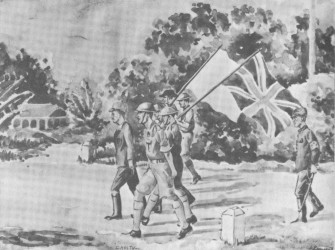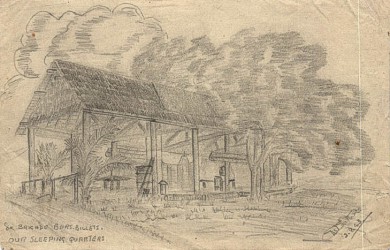|
At the fall of Singapore , the 80,000 allied troops were ordered to get to the Army Camp area at Changi by the 17th February. Changi is in the North-East of Singapore, the first to arrive were the Royal Norfolks who were defending that part of the island, so they did get the choice of the quarters.
|

|
|
Surrender
|
|
by Leo Rawlings
|
|
© Copyright J.Mullender 1990
|
|
At 2pm on the 17th February Japan held its victory march through Singapore complete with its fifth column in their Malay and Chinese dress. This is how the Japanese knew in advance which roads to take to get behind the allied lines, causing the allied forces to retreat down Malaya and then into Singapore, till there was nowhere else to go. Then with the Japanese air and tank supremacy, surrender was the only choice.
|
|
|
Birdwood Camp - Changi
|
|
by Leo Rawlings
|
|
© Copyright J.Mullender 1990
|
|
Changi was very overcrowded and within a few days the food supplies had ran out. The Japanese then sent in sacks of rice. At first two to three ounces were issued per man, but it had to be increased to ten ounces as it did not provide nourishment. This new diet provided its problems, it took five months for the stomach to adjust and get the goodness from the rice. This caused swollen joints and dysentery thus creating a bigger need for hospital space.
 The camp at Changi grew outside the Army Camp perimeter and the rain did not stop. There was a shortage of tents, so the prisoners copied the native dwellings and learnt to build atap huts. The camp at Changi grew outside the Army Camp perimeter and the rain did not stop. There was a shortage of tents, so the prisoners copied the native dwellings and learnt to build atap huts.
An atapi hut has an inverted V-shaped roof made of bamboo poles, thatched with atap.
Atap is a thatch made from Nipah Palm. The thatch had to be tight or rain would seep through it and wet the bamboo shelves which ran down each side of the hut with a gang way in the middle. The shelves were the sleeping quarters for the prisoners. Bamboo is of course hollow and the beds soon got infested with bugs which hid in the bamboo during the day and feasted at night.
The cooks tried different ways of presenting the rice to the prisoners.
These included:
A Black Market began to flourish, this was run by officers who could speak Malay, small tins of milk in Singapore were about 50 cents, these were fetching 5 or 6 dollars in Changi. The prisoners were running out of money and valuables fast, the earth was then worked to produce vegetables in about an acre of the Battalion ground.
The Japanese were now using the Free Indian Army as sentries, and many a clout was given to the prisoners for any reason, life was getting intolerable and could not get any worse, or so the prisoners thought.
Men volunteered to work on the Singapore Docks as food could be obtained, the prices were about 200% less then in Changi, with nowhere to escape to the prisoners had learnt to adjust.
The 1,200 prisoners taken during the Japanese advance down Malaya had eventually been taken to Puda Jail in Kuala Lumpur, they found themselves in an even worse situation then the prisoners in Changi. The Japanese had complete control over the prison, where in Changi they rarely saw any Japanese and the prison was run by the captured officers. Although food was sparse in Changi, the surrendered troops did have time to collect belongings and food, whilst the prisoners in Puda Jail were taken in battle and had no time to collect anything.
Puda jail was severely overcrowded and the Japanese did not help in their organisation of the prison quarters. Most of the prisoners had been wounded in the battle for Malaya and they needed medical treatment badly, the hospital was too small to cope with all the cases. During the six months in Puda Jail 100 men died of their wounds or disease. After a few months the Japanese did open another part of the prison and the conditions did start to improve.
The 8,000 British and Australian troops which made up the commonwealth garrison on Java, had an equally bad time of it when Java surrended. To these prisoners the many Dutch military and civilian prisoners were added and also the survivors of the USS Houston and HMAS Perth. These two allied cruisers were sunk by the Japanese Navy off Batavia whilst trying to escape from Java on its surrender. Many hundreds of the crew members lost their lives in this action and the survivors were taken to a cinema at Serang. The cinema was built to seat a maximum 500 people but 1,500 prisoners were squeezed into it. There was no medical assistance for the many wounded, the food was very poor rice and they had no washing facilities. Later some of these men were transferred to Serang Jail but this soon became as overcrowded with each cell holding thirty-four men when in normal time the cells held a maximum of eight prisoners. There was little trading for food, as the natives were very anti-European, the situation for the prisoners could not get any worse. The Japanese now sent these prisoners to the “Bicycle Camp” where the conditions improved considerably, out of 3,000 prisoners housed here there were only six deaths.
Many of the small ships which had tried to escape from Singapore in its last days, were captured or sunk in the narrow Banka Strait off the coast of Sumatra, among those captured were 500 British personnel. These were imprisoned at Padang on the west coast of Sumatra and would later make up the British Sumatra Battalion who worked from the Burma end of the line with the Australian ‘A’ Force.
The Japanese were now promising the prisoners at Changi, Puda, Batavia and Padang, “Rest Camps” in Thailand and Burma. In June the first parties left Singapore by train and boat to their destinations, they were never to believe a Japanese promise again.
|